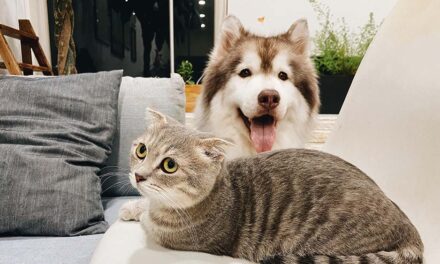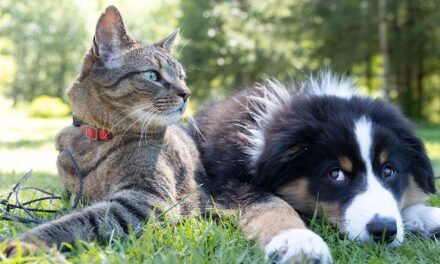Just what constitutes the best or most appropriate diet for a pet is quite a controversial topic and there are as many opinions as there are doctors. Often the opinions are based more on emotion than on objective medical facts. When it comes to having facts to back one view or the other, sometimes they are hard to find.
No matter which type of diet—homemade or processed—is chosen, it must meet at least five requirements:
- The diet must contain the proper amount and balance of essential nutrients required by the pet.
- The ingredients must be of high nutritional quality so that the animal can effectively digest, absorb and utilize the dietary nutrients.
- The diet should be palatable so that the pet will eat it.
- The diet should contain minimal to no fillers such as animal or plant by-products (or if by-products are present, as in the case of some prescription-type diets for sick pets, the diet should contain the least amount of by-products).
- The diet should contain no artificial colors, flavors, chemical preservatives or additives, when possible.
No matter which type of diet you choose to feed your pet, it should meet the above requirements.
While many holistic pet owners prefer to cook for their pets, many others must choose a processed diet for a variety of reasons. If you are one of those who must feed processed food, it is important to learn as much as possible about processed pet foods so you can make the most intelligent choice. The following information will be helpful when you make your choice. Processed foods have been around for about 40 to 50 years. Prior to the introduction of processed foods, our pets ate what people ate (or leftovers of what people ate). Many holistic pet owners feel that pets fared much better as a result of these fresher homemade diets and that many diseases (such as immune disorders and arthritis) are diseases of processed food.
Processed foods were introduced (like vitamin-mineral supplements) for two main reasons:
- Convenience
- Prevention/treatment of nutritional diseases.
There is no question that it takes time to prepare properly homemade pet diets and that using processed foods saves pet owners a large amount of time. It is convenient to simply open a can or scoop a cup of food from a bag and feed the pet. Processed foods not only save people time when it comes to food preparation but they make feeding the pet quick and easy.
Processed foods were also introduced to prevent (and treat) nutritional diseases. It takes a lot more than simply tossing him some scraps to give your pet a complete, balanced and nutritional diet. Prior to our understanding of nutrition, people and pets alike suffered from diseases resulting from dietary imbalances.
For example, people who didn’t receive citrus fruits were diagnosed with scurvy as a result of vitamin C deficiency. Pets fed mainly meat developed nutritional osteodystrophy (nutritional secondary hyperparathyroidism) as a result of calcium deficiency. Cats fed only fish developed thiamine deficiency and steatitis. By learning about the nutritional needs of pets and formulating balanced diets, you can avoid these nutritional problems. While many of the nutritional diseases seen prior to the introduction of processed diets have been all but eliminated, many holistic veterinarians believe without question that processed foods, specifically those of little nutritional quality and loaded with by-products and chemicals, may actually contribute to a whole new set of problems such as immune diseases, cancers, allergies and arthritis.
Many years ago we had but few choices of processed pet foods. As manufacturers have seen the profit in the pet food industry, we now see more players and many more choices. As well-known manufacturers of pet foods have reaped huge profits, large corporations have purchased the ownership of the foods. As a result, even many conventional veterinarians who promoted certain brands of food in the past have seen a decline in food quality and pet health as the dietary formulations have changed.
For example, let’s take a look at Hill’s Science Diet, formally manufactured by the Morris Company. Science Diets were originally designed as a line of medical, therapeutic diets for pets with medical conditions (the first diets for pets with kidney failure). The company, under the leadership of Dr. Mark Morris, was the first pet food company to look at the potential beneficial role of diet in helping pets with medical disorders—many of which can be managed only by dietary therapy as no drug therapy is available to correct the problem.
Science Diet is now owned by Colgate-Palmolive. In 1986 Hill’s prescription diet formulation and production was still under the direct supervision of Mark Morris Associates. Since that time there have been some major changes. Mark Morris Associates was reformed as an independent group and Colgate-Palmolive made some major marketing changes. About this time, meals started showing up on the ingredient list. Formulations underwent major changes, supposedly for “nutritional” reasons, though most changes seemed to use cheaper ingredients. They violated the basic principle that premium diets are more expensive because they adhere to consistent formulation, regardless of commodity cost. Thus they were “better” than popular diets because the animal wouldn’t be subjected to unexpected variations in the diet, reducing the risk of diarrhea in sensitive animals. Formulations were changed significantly without warning. Many doctors who still promote the Science Diet line believe that current formulations are not of the higher quality they were 15 years ago.
Note: This discussion is not meant to pick on Science Diet, as many of the better—known processed foods are also questioned as to their use for long-term feeding by many holistic veterinarians. These include: Proctor & Gamble (Iams), Colgate-Palmolive (Hills), Nestle (Friskies, Alpo) and Heinz (9 Lives, Nature’s Recipe, Kibbles n Bits). However, since Science Diet is among the better-known foods, it is used here as our example.
While Hill’s (and Iams and a few other well-known brands) used to be the “gold standard” in commercial pet foods, most holistic veterinarians do not recommend their long-term use for most pets.
These companies, as a rule, maintain beautiful, spotless, accredited production facilities. Those facilities aren’t where the problem lies; instead, the raw materials coming in the back door are suspect (not to mention the facilities from whence these raw materials come: slaughterhouses and rendering plants).
Individual pets have specific needs and some do better on one diet than on another. For example, Science Diet is a line of a number of scientifically formulated diets tested on several breeds of dogs during formulation. Some pets can handle their diets, whereas others develop diarrhea, vomiting or itching.
However, the man-made diets are made with human-grade fresh ingredients without the addition of chemical additives, whereas many commercial foods are not made using the best ingredients and have hormones, pesticides and a number of additives. Ultimately, since your pet is an individual, you will need to work with your veterinarian to see just which diet is best for your pet.
Processed foods purport to be complete and balanced. Consumers feed them because they are convenient. Yet processing removes many nutrients (such as enzymes and probiotic bacteria, as well as many of the yet undiscovered phytonutrients) that are not added back to the diet after processing. While most pets can live seemingly normal lives on many processed foods, we have to admit that we really don’t know every nutrient (and every level of nutrient) that every dog or cat needs. Many foods contain ingredients dogs and cats were not designed to eat—for example cereals such as wheat, barley and oatmeal; meat and bone meal; soybean meal; ground corn; soy flour and soy grits. Additionally, many processed foods designed for feeding cats contain large amounts of grain, especially corn. This occurs since grains are less expensive sources of protein than meat. However, cats are true carnivores, not omnivores; even dogs, being more omnivorous than cats, benefit from diets composed of meat. A strict dietary carbohydrate requirement for cats has not even been identified. Many holistic diets point to processed, high-grain cat foods as a cause of diseases such as diabetes, which are much less common in cats that are fed meat-based (true carnivore) diets.
Feeding the better wholesome processed foods (or better yet, homemade diets) supplemented with natural vitamins and minerals, omega-3 fatty acids, enzymes, probiotics, green foods and health blend formulas allow us to match as closely as possible diets consumed by wild relatives of our domestic pets.
There are at least three classifications of processed diets: the least expensive generic diets, the more expensive premium diets and the most expensive natural diets.
Generic diets are the least expensive but also the least healthful for your pet. Manufacturers use the cheapest ingredients possible. These are the foods that contain ingredients such as animal and plant by-products. Generic diets also are more likely to contain numerous preservatives and additives. Once again, read the label. Most generic foods are not fed to pets in feeding trials but rather meet arbitrary nutritional standards. Owners should not consider this type of food because health problems, due to nutritional deficiencies, may result.
Premium foods are available at many pet stores and veterinary hospitals. They usually have higher quality ingredients than do generic diets. However, you must read the label on these foods. While these diets are far better than generic diets, many contain animal and plant products raised with chemicals and hormones. While some of these premium foods can be acceptable choices when properly augmented with natural supplements, they are not usually the first choice of holistic veterinarians and pet owners if the more natural diets are available. For many of these diets, however, the only thing premium about them is the price. Reading the label will help give you some guidelines about which foods to avoid and which ones are appropriate to feed your pet.
The natural diets are the most premium of foods. These diets usually contain nothing artificial—no artificial colors or flavors. They use more expensive ingredients; depending upon the brand, these ingredients are raised organically without chemicals or hormones. However, some of these diets may also rely too much on grains, especially in their diets for cats, making homemade diets the best choice when this option is possible. Because of this insistence on quality and health, natural diets are the best processed foods (and many would argue the only prepared foods) you should feed your pet if you choose not to prepare a homemade diet. (Once again, read the label. Many new companies see the potential profit in making “natural diets,” often leaving it up to the owner or doctor to read the label and pick which foods are truly better for the pets.) Since these natural diets are the most popular with owners seeking a holistic approach to raising pets and the most healthful for the pets, let’s take a closer look at what makes these diets so good for your pet.
The natural diets differ from most other prepared diets in four ways:
- They use only human grade, high-quality ingredients. (Other prepared diets may use by-products of foods processed for but declared “unfit” for use by humans.)
- They use foods, especially grains, in their whole state rather than parts of the foods.
- They use no artificial colors, additives, chemicals or preservatives.
- They formulate diets for optimum nutrition.
In order to appreciate the difference between these three classes of prepared diets, it’s important to learn to read the label and understand the differences behind the ingredients listed in the diets.











